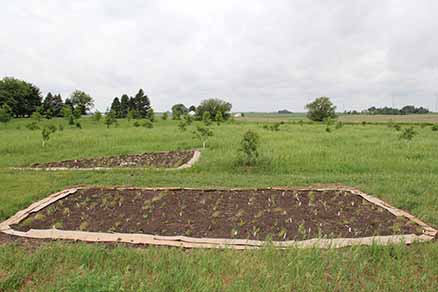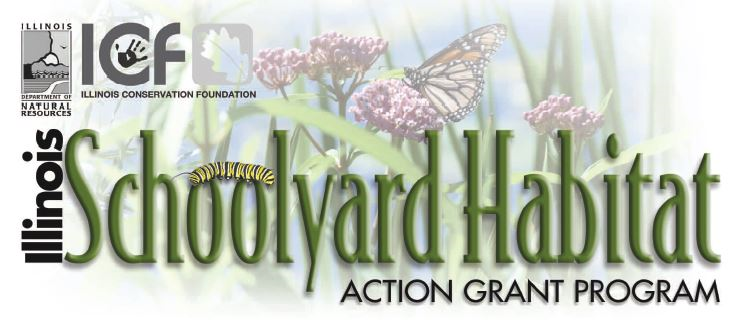Schoolyard Habitat Action Grant Program Demonstration Gardens
Demonstration gardens for the Illinois Schoolyard Habitat Action Grant program have been installed at the M. J. Rhymer Family Dry Grove Nature Preserve in Normal. Updates will be posted to this Web page. This project was made possible by the U.S. Fish and Wildlife Service's Partners for Fish and Wildlife Program, the Illinois Conservation Foundation, the Natural Resources Conservation Service and the M. J. Rhymer Family Dry Grove Nature Preserve.
Native plants provide beauty as well as food and shelter for wildlife. Native plant species are adapted to the Illinois climate. They require little or no watering and are resistant to drought, insect damage and most diseases. Because they are perennials, you can welcome their presence year after year. They add interest, and often color, to gardens in all seasons. Using native plants in landscaping can provide economic, educational and environmental benefits. The demonstration gardens at M. J. Rhymer Family Dry Grove Nature Preserve help to highlight several advantages for using native plants in landscaping and for using other practices that can be easily implemented and maintained while benefitting the local environment. In May 2014, raised-bed gardens, prairie gardens and permeable pavers were installed.
Native plants in landscaping can provide economic benefits.
a. Maintenance costs are reduced by decreasing mowing, watering, fertilizing, trimming and use of pesticides.
b. The project will provide an example that can be used to stimulate an important component of the Illinois Green Industry.
Native plants in landscaping can provide environmental benefits.
a. Soil quality is improved, and soil erosion will be reduced.
b. Stormwater runoff and its impacts will be reduced.
c. Water quality will be enhanced.
d. Wildlife habitat will be restored.
Native plants in landscaping can provide educational/recreational benefits.
a. The project will provide an economically and environmentally sustainable natural landscaping model that can be emulated by citizens, private organizations, businesses and government agencies.
b. The landscaping will provide an opportunity to perform outreach and education for the general public about Illinois' natural resources, their stewardship and the value of natural landscaping.
c. Representations of Illinois' primary habitats will be developed.
d. The importance of habitat to wildlife will be promoted.
e. Volunteer opportunities will be provided for the general public, youth groups and students/teachers allowing them to see that their actions can make a difference in the world.
f. The natural landscaping will provide an opportunity to teach people techniques and skills to raise native plants in other locations and circumstances.
g. The landscaping will provide places where people can connect with nature.
Prairie Gardens

A prairie is a type of grassland. Prairies usually form on level or smoothly rolling landscapes in areas with hot, dry summers and cold winters. The parts of the plants above the surface of the soil are killed each winter, but new plants regenerate from the roots each spring. Grasses and forbs (wildflowers) are the main components of prairies. Grasses have narrow leaves, while forbs have broad leaves. In 1820, Illinois had 22 million acres of prairies. Today, very little natural prairie remains in the state.
Two prairie gardens were installed. They feature native plants that were once abundant in this location.
Advantages:
- extensive roots soak up water and slow erosion
- increase local biodiversity
- very low maintenance
- perennial plants
- reduced costs over time compared to annual plants
- resistant to drought, cold, diseases and insects
- great variety of heights, shapes, flower color and blooming period
- attractive throughout the year
- provide wildlife habitat
- decrease expenses and pollution from mowing
Size:
A prairie garden can be any size. An existing perennial bed may be enhanced or a new one established.
Light:
Six hours or more per day of full sun should be available.
Water:
No water is needed after the plants are established (after one to two years).
Elevation/Topography:
Level ground is best for a prairie, but a south-facing hillside is doable, as is an east or west-facing hillside. North slopes should be avoided.
Soil:
Native plants will grow in a variety of soils: dry and mesic (moderately moist) plants do well in loose soils with good drainage, while wetland plants will do well when drainage is poor (standing water three to four hours after rainfall). Soil may be amended using sand.
Plant Materials:
Sun-loving native forbs and grasses are recommended. See link below to "Types of Plants."
Planting and Maintenance:
See link below to "How to Plant and Maintain Native Plants."
Special Considerations:
Patience: Because native plants need to develop vast root systems, a prairie planting may take several years (five or more) to look mature, especially if started with seeds.
Raised-bed Gardens
A raised-bed garden is built on top of the soil. It does not contain a liner, so plant roots can enter the soil below the raised-bed. If your soil is poor, a raised-bed garden can allow you to avoid the native soil and use the type of soil that works best for your goals. All types of plants can be grown in a raised-bed garden.
Advantages:
exclude weeds
reduce soil compaction
provide a physical pest barrier
allow for good soil drainage
minimize soil erosion
plant earlier in the spring because the soil in the boxes warms quicker than adjacent soil in the ground
roots can grow into the soil below the raised bed
easy to reach for the gardener
Size: The size can vary. Some raised-bed gardens are completely contained by lumber, stones, etc., while others may be more open on the sides.
Light: The raised bed may be placed in full sun, partial shade or full shade for the appropriate plant materials.
Water: Native plants in a raised bed will be exposed to much harsher conditions than in the soil, so extra watering may be required. Morning watering is preferred.
Fertilizer: Native plants normally do not require fertilizer.
Exposure: Keep in mind that raised-bed gardens are exposed to the elements on all sides, and plant materials are subject to much higher or lower temperatures than they would encounter in the soil. Extreme temperatures can damage roots, eventually weakening the plants and possibly causing death. Be vigilant and remove the plant(s) to a garden bed at the first signs of stress.
Soil: Native plants grow in a variety of soil types.
Planting Materials: Research your native plant choices before purchase. Consider light and water requirements, height, color, length of bloom time, etc. See the link below for the "Plants to Use" list.
Special Considerations: Summer Duty: Raised-bed gardens will have to be monitored over the summer months for watering, deadheading and possibly replanting.
Permeable Pavers
 The walkway to the gazebo and the edge of the rock border of the gazebo are composed of permeable pavers. Water can move through the spaces between the pavers, providing natural drainage and percolation into the earth.
The walkway to the gazebo and the edge of the rock border of the gazebo are composed of permeable pavers. Water can move through the spaces between the pavers, providing natural drainage and percolation into the earth.
Advantages:
reduce stormwater runoff
increase water absorbed in the soil
decrease pollutants reaching surface waters
groundwater recharge
less downstream flooding
deter soil erosion
minimize thermal impacts on streams
Permeable paving provides an avenue for storm water to be captured and slowly released into the soil. The pavers are made of concrete or fired clay brick. They are designed to support heavy loads of traffic and are often used in roads, walkways and parking lots. Water does not enter the paving blocks. It passes into the spaces around the pavers and is held by base layers of aggregate materials under the pavers for gradual release and filtration of pollutants. The spaces between the pavers are filled with sand or a crushed rock material.
Preparing the Site
Marking - March 1, 2014 - Flags were used to mark the proposed locations of the two prairie gardens.
Additional Marking - May 4, 2014 - The locations for the raised-bed gardens and porous pavers were flagged before construction began. Soil was also removed so that the porous pavers could be installed.
Spraying - May 4, 2014 - An herbicide was sprayed on the area that would contain the prairie gardens. The herbicide was used to kill the grasses (nonnative) and other vegetation that were currently growing in this location.
Cultivating - May 12, 2014 - After giving the herbicide application one week to be effective, the prairie gardens were cultivated with a roto-tiller. The exisiting plant residue was removed.


